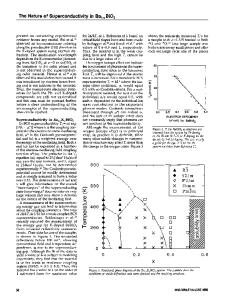Superconductivity Above 77 K in the Cubic Ba 2 Ycu 2 Wo 9-Y Oxide System
- PDF / 229,902 Bytes
- 4 Pages / 420.48 x 639 pts Page_size
- 41 Downloads / 317 Views
SUPERCONDUCTIVITY ABOVE 77 K IN THE CUBIC Ba 2 YCu 2 WO9 _y OXIDE SYSTEM BOKHIMI, and A. GARCIA-RUIZ Instituto de Fisica, UNAM, a. p.
20-364,
01000 Mexico,
D. F.,
Mexico.
ABSTRACT We have obtained a new family of oxide superconductors, which are characterized by a cubic structure with the space group Fm3m and transition temperatures to the superconducting state above 77 K. As prototype of this family, we have studied some properties of the Ba YCu 2 WO9 system. We report details about the experimental conditions tNat are-Ynecessary in order to obtain the cubic structure and to change the charge carrier density. The samples show superconducting behavior around 90 K with only a small Meissner effect fraction. These results can be interpreted in terms of filamentary superconductivity, however, it is necessary to characterize the system further to give a correct interpretation of the results.
INTRODUCTION Recently we announced the discovery of a new family of high Tc superconductors with transition temperature to the superconducting state around 90 K [1]. The compounds of this family are given by the formula M RCu TO , where M is an alkaline earth, R is Y or a rare earth and T can 2 be W, MWYNb, Ta, Sb, Sn, Bi and Pb. These are the first oxides with cubic structure that show superconductivity above 77 K. However in that announcement there were some problems with the observed parameter that define each system, as for example: a low charge carrier density, a small Meissner effect fraction and the appearance of extra peaks in the X-ray diffractogram which could not be indexed with a cubic structure with the
space group Fm3m. Also some people felt that at the beginning of the research in high Tc superconductors, a similar substitution to that reported in this work was attended, but without succees [2]. In this paper we report additional experimental details about our sample preparation and the role of the oxygen deficiency in the structure and in the electrical properties of the sample. EXPERIMENTAL The samples were prepared by solid state reaction. Appropiate amounts of BaCO3 , Y 03 , CuO and W03 were well mixed and calcined in air at 800 C for 2 hours? 3The sintering of the samples was done also in air at temperatures between 850 C and 1200 C, depending on the tungsten concentration. The cooling conditions of the sample were not controlled. The samples were reground and sintered several times. After the sintering,
the
single phase samples with the cubic structure were further
heated at 450 C, some of them in flowing oxygen for 12 others in flowing hydrogen for 30 minutes.
hours,
and
some
The structure of the samples was analyzed by X-ray diffraction with Cu radiation. The electrical resistance as function of temperature was measured with the four probe technique. The magnetization as function of temperature and magnetic field was measured with a PAR vibrating-sample
magnetomer in magnetic fields lower then 0.62 Tesla.
Mat. Res. Soc. Symp. Proc. Vol. 169. ©1990 Materials Research Society
234
RESULTS AND
Data Loading...











